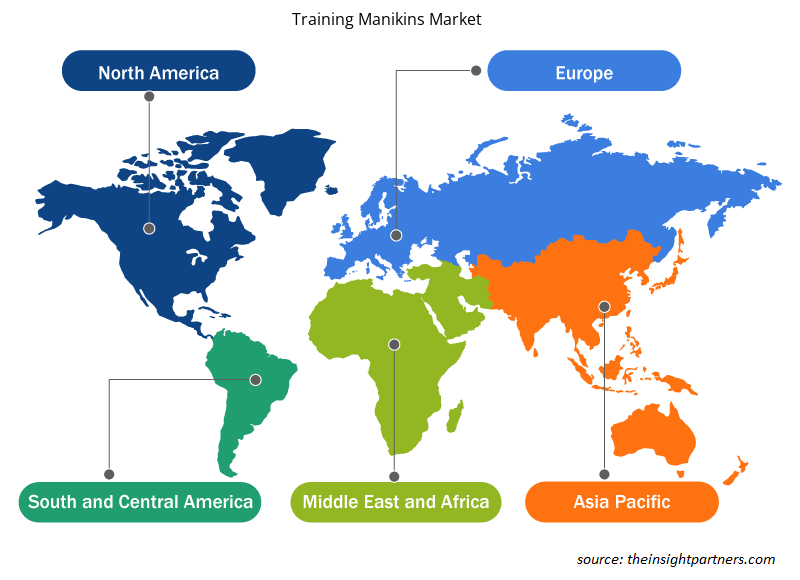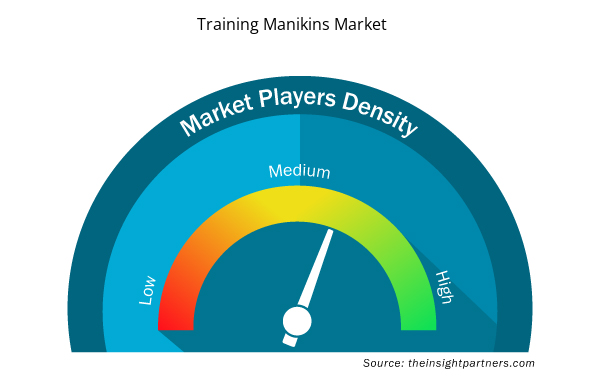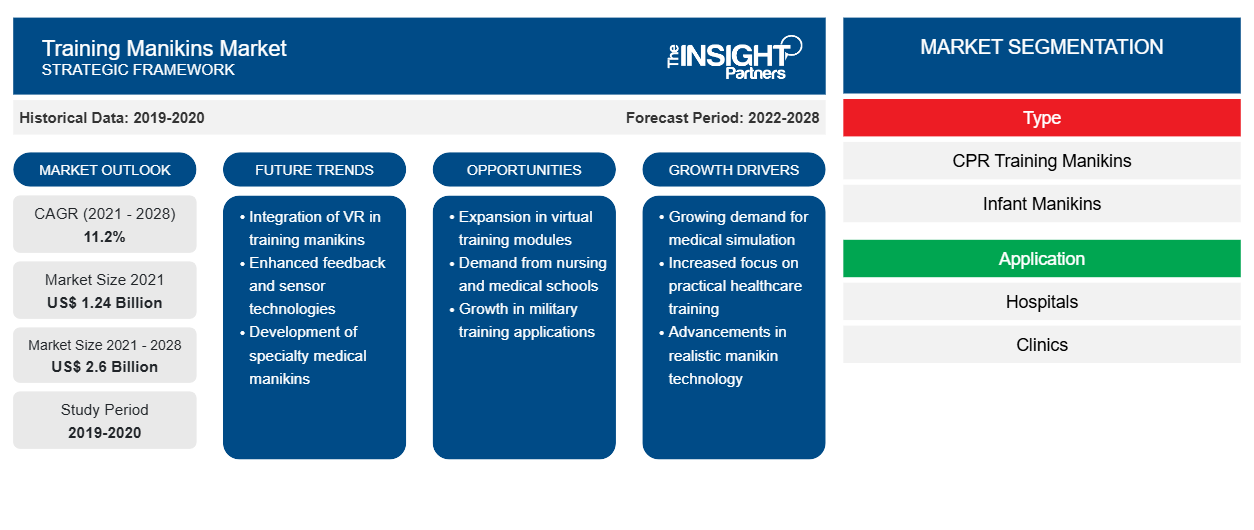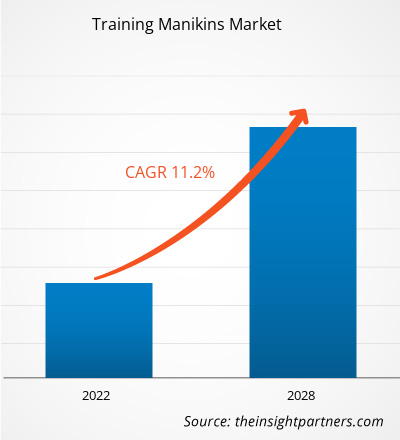Der Markt für Trainingspuppen soll von 1.235,61 Millionen US-Dollar im Jahr 2021 auf 2.603,89 Millionen US-Dollar im Jahr 2028 anwachsen. Der globale Markt für Trainingspuppen soll im Zeitraum 2021–2028 mit einer durchschnittlichen jährlichen Wachstumsrate von 11,2 % wachsen.
Trainingspuppen sind Nachbildungen eines Erwachsenen, Kindes oder Säuglings mit simulierten Atemwegen, Organen oder Organsystemen. Sie werden verwendet, um CPR, erweitertes Atemwegsmanagement und chirurgische Verfahren zu lehren und zu trainieren. Trainingspuppen können den ganzen Körper darstellen oder nur die relevanten Körperteile aufweisen, die für das Training oder die Demonstration erforderlich sind. Trainingspuppen werden seit den 1950er Jahren für Demonstrationen und das Training der Durchführung von CPR verwendet. Der Einsatz von Robotern und anderen Technologien hat das reaktionsschnelle Feedback der Puppen weiter verbessert, was zu besseren Lernerfahrungen geführt hat.
Das Wachstum des Marktes für Trainingspuppen ist auf den Fortschritt der Technologie für Trainingspuppen und die weltweit steigende Zahl von Herzstillständen außerhalb von Krankenhäusern zurückzuführen. Probleme im Zusammenhang mit der Realitätsnähe der Trainingspuppen könnten das Wachstum des Marktes für Trainingspuppen im Prognosezeitraum jedoch behindern.
Passen Sie diesen Bericht Ihren Anforderungen an
Sie erhalten kostenlos individuelle Anpassungen an jedem Bericht, einschließlich Teilen dieses Berichts oder einer Analyse auf Länderebene, eines Excel-Datenpakets sowie tolle Angebote und Rabatte für Start-ups und Universitäten.
- Holen Sie sich die wichtigsten Markttrends aus diesem Bericht.Dieses KOSTENLOSE Beispiel umfasst eine Datenanalyse von Markttrends bis hin zu Schätzungen und Prognosen.
Markteinblicke
Die zunehmende Häufigkeit von Herzstillständen außerhalb von Krankenhäusern sowie Schulungs- und Aufklärungsprogramme zur kardiopulmonalen Wiederbelebung (CPR) treiben den Markt für Trainingspuppen an
Eine 2020 veröffentlichte Studie mit dem Titel „Die weltweite Überlebensrate bei erwachsenen Patienten mit Herzstillstand außerhalb eines Krankenhauses, die eine kardiopulmonale Wiederbelebung erhielten: Eine systematische Überprüfung und Metaanalyse“ untersuchte die Überlebensraten von Patienten mit einem OHCA , die durch einen Umstehenden oder den Rettungsdienst eine Herz-Lungen-Wiederbelebung erhielten und in einer bestimmten Region lebten. Die Studie berichtete von einem signifikanten Anstieg der Überlebensraten nach einem OHCA in den letzten Jahren, und die Raten sind bei Patienten, die eine Herz-Lungen-Wiederbelebung erhielten und in westlichen Ländern lebten, höher. Eine der am häufigsten verwendeten Verwendungsmöglichkeiten von Trainingspuppen ist das Training in Herz-Lungen-Wiederbelebung. Herz-Kreislauf-Erkrankungen ( CVDs ) sind weltweit die häufigste Ursache für Morbidität und Mortalität. Die Weltgesundheitsorganisation (WHO) schätzt, dass 17,9 Millionen Menschenleben aufgrund von CVDs verloren gehen , d. h . 32 % aller Todesfälle werden jedes Jahr weltweit gemeldet. Vier von fünf CVD-bedingten Todesfällen sind Herzinfarkte und Schlaganfälle. Das Bewusstsein für die Herz-Lungen-Wiederbelebung (CPR) ist in westlichen Ländern hoch. Im Jahr 2019 ereigneten sich in Europa und den USA etwa 700.000 Fälle von Herzstillständen außerhalb von Krankenhäusern ( OHCA ), wobei ein erheblicher Prozentsatz davon zu Hause und in der Öffentlichkeit auftrat. Außerdem wurde beispielsweise in Großbritannien von der Advanced Coronary Treatment (ACT) Foundation ein Trainingsprogramm für Sekundarschüler eingeführt, die mit den British Columbia Emergency Health Services ( BCEHS ) verbunden sind. Freiwillige Sanitäter bilden Lehrer aus, um Schüler der BCEHS zu unterrichten . An einigen Universitäten plant die BCEHS , das Training mit Trainingspuppen als Teil des Sportunterrichts einzuführen. „Nation of Lifesavers – Call, Push, Rescue“ der British Heart Foundation ist ein weiteres Beispiel für ein vereinfachtes Trainingsprogramm, das sich auf CPR nur mit Kompression und AED konzentriert . Die British Heart Foundation hat auch die Führung übernommen, um medizinische Fachkräfte zu mobilisieren, um die öffentliche Aufklärung in Großbritannien zu unterstützen. Insgesamt erlebt der Markt für Trainingspuppen dank Sensibilisierungs- und Trainingsprogrammen, die von staatlichen und lokalen Stellen organisiert werden, ein stetiges Wachstum.
Typbasierte Erkenntnisse
Basierend auf dem Typ wurde der globale Markt für Trainingspuppen in CPR-Trainingspuppen, Säuglingspuppen und Sonstiges segmentiert. Das Segment CPR-Trainingspuppen wird voraussichtlich 2021 den größten Anteil am Markt für Trainingspuppen halten. Das Segment CPR-Trainingspuppen wird voraussichtlich die schnellste durchschnittliche jährliche Wachstumsrate (CAGR ) von 11,7 % zwischen 2021 und 2028 aufweisen, da die Zahl plötzlicher Herzstillstände außerhalb von Krankenhäusern ( OHCA ) mit ineffektiver kardiopulmonaler Wiederbelebung (CPR) weltweit die dritthäufigste Todesursache ist.
Regionale Einblicke in den Markt für Trainingspuppen
Die regionalen Trends und Faktoren, die den Markt für Trainingspuppen während des Prognosezeitraums beeinflussen, wurden von den Analysten von Insight Partners ausführlich erläutert. In diesem Abschnitt werden auch die Marktsegmente und die Geografie von Trainingspuppen in Nordamerika, Europa, im asiatisch-pazifischen Raum, im Nahen Osten und Afrika sowie in Süd- und Mittelamerika erörtert.

- Erhalten Sie regionale Daten zum Markt für Trainingspuppen
Umfang des Marktberichts zu Trainingspuppen
| Berichtsattribut | Details |
|---|---|
| Marktgröße im Jahr 2021 | 1,24 Milliarden US-Dollar |
| Marktgröße bis 2028 | 2,6 Milliarden US-Dollar |
| Globale CAGR (2021 - 2028) | 11,2 % |
| Historische Daten | 2019-2020 |
| Prognosezeitraum | 2022–2028 |
| Abgedeckte Segmente | Nach Typ
|
| Abgedeckte Regionen und Länder | Nordamerika
|
| Marktführer und wichtige Unternehmensprofile |
|
Dichte der Marktteilnehmer für Trainingspuppen: Die Auswirkungen auf die Geschäftsdynamik verstehen
Der Markt für Trainingspuppen wächst rasant, angetrieben durch die steigende Nachfrage der Endnutzer aufgrund von Faktoren wie sich entwickelnden Verbraucherpräferenzen, technologischen Fortschritten und einem größeren Bewusstsein für die Vorteile des Produkts. Mit steigender Nachfrage erweitern Unternehmen ihr Angebot, entwickeln Innovationen, um die Bedürfnisse der Verbraucher zu erfüllen, und nutzen neue Trends, was das Marktwachstum weiter ankurbelt.
Die Marktteilnehmerdichte bezieht sich auf die Verteilung der Firmen oder Unternehmen, die in einem bestimmten Markt oder einer bestimmten Branche tätig sind. Sie gibt an, wie viele Wettbewerber (Marktteilnehmer) in einem bestimmten Marktraum im Verhältnis zu seiner Größe oder seinem gesamten Marktwert präsent sind.
Die wichtigsten auf dem Markt für Trainingspuppen tätigen Unternehmen sind:
- Ambu, Inc.
- Gaumard Scientific Company, Inc
- Laedral Medical A/S
- Lebensrettende Ressourcen, Inc.
- Medizinische Bildungstechnologien, Inc.
Haftungsausschluss : Die oben aufgeführten Unternehmen sind nicht in einer bestimmten Reihenfolge aufgeführt.

- Überblick über die wichtigsten Akteure auf dem Markt für Trainingspuppen
Anwendungsbasierte Erkenntnisse
Basierend auf der Anwendung ist der globale Markt für Trainingspuppen in Krankenhäuser, Kliniken und andere unterteilt. Das Segment Krankenhäuser wird voraussichtlich im Jahr 2021 den größten Marktanteil halten. Darüber hinaus wird erwartet, dass das Segment im Zeitraum von 2021 bis 2028 aufgrund der zunehmenden Verwendung von Trainingspuppen in Krankenhäusern auf der ganzen Welt das schnellste CAGR-Wachstum von 11,8 % verzeichnen wird.
Produkteinführungen und -zulassungen sind häufig von Unternehmen angewandte Strategien, um ihre globale Präsenz und ihr Produktportfolio zu erweitern und den Marktanteil von Trainingspuppen zu dominieren. Darüber hinaus konzentrieren sich die Marktteilnehmer von Trainingspuppen auf die Partnerschaftsstrategie, um ihren Kundenstamm zu vergrößern, was ihnen wiederum ermöglicht, ihren Markennamen weltweit aufrechtzuerhalten. Es wird erwartet, dass der Marktanteil von Trainingspuppen mit der Entwicklung neuer innovativer Produkte durch die Marktteilnehmer von Trainingspuppen florieren wird.
Firmenprofile
- Ambu, Inc
- Gaumard Scientific Company, In
- Laedral Medical A/S
- Lebensrettende Ressourcen, Inc.
- Medizinische Bildungstechnologien, Inc.
- Simulaids, Inc.
- Die Aristotle Corp.
- Amerikanische Herz-Lungen-Wiederbelebung
- Nasco
- : TruCorp.
- Historische Analyse (2 Jahre), Basisjahr, Prognose (7 Jahre) mit CAGR
- PEST- und SWOT-Analyse
- Marktgröße Wert/Volumen – Global, Regional, Land
- Branche und Wettbewerbsumfeld
- Excel-Datensatz



Report Coverage
Revenue forecast, Company Analysis, Industry landscape, Growth factors, and Trends

Segment Covered
This text is related
to segments covered.

Regional Scope
North America, Europe, Asia Pacific, Middle East & Africa, South & Central America

Country Scope
This text is related
to country scope.
Häufig gestellte Fragen
The factors that are driving the growth of the market are the advancements in the technologies used in the development of manikins and the increasing prevalence of out-of-hospital cardiac arrests and cardiopulmonary resuscitation training and awareness programs. Moreover, the training for COVID-19 pandemic and the use of remote training have provided growth opportunities to the market.
The training manikins market majorly consists of the players such as Ambu, Inc., Gaumard Scientific Company, Inc., Laedral Medical A/S, Simulaids, Inc., American CPR, Nasco Healthcare, TruCorp., and CAE Inc., among others.
Training manikins are a replica of an adult, child, or infant human with simulated airways, organs, or organ systems. These are used for teaching and training of CPR, advanced airway management, and surgical procedures. Training manikins can be full-body or have only the relevant body parts necessary for the training or demonstration. As technology has developed, the training manikins have become more sophisticated with airways, organs, and organ systems that resemble the human anatomical systems that have been made to provide a high-fidelity experience to the user. The use of robotics and other technologies has further improved the responsive feedback of the manikins which have aided in better learning experiences.
Trends and growth analysis reports related to Life Sciences : READ MORE..
The List of Companies - Training Manikins market
- Ambu, Inc.
- Gaumard Scientific Company, Inc
- Laedral Medical A/S
- LifeSaving Resources, Inc.
- Medical Education Technologies, Inc.
- Simulaids, Inc.
- The Aristotle Corp.
- American CPR
- Nasco
- TruCorp.
The Insight Partners performs research in 4 major stages: Data Collection & Secondary Research, Primary Research, Data Analysis and Data Triangulation & Final Review.
- Data Collection and Secondary Research:
As a market research and consulting firm operating from a decade, we have published and advised several client across the globe. First step for any study will start with an assessment of currently available data and insights from existing reports. Further, historical and current market information is collected from Investor Presentations, Annual Reports, SEC Filings, etc., and other information related to company’s performance and market positioning are gathered from Paid Databases (Factiva, Hoovers, and Reuters) and various other publications available in public domain.
Several associations trade associates, technical forums, institutes, societies and organization are accessed to gain technical as well as market related insights through their publications such as research papers, blogs and press releases related to the studies are referred to get cues about the market. Further, white papers, journals, magazines, and other news articles published in last 3 years are scrutinized and analyzed to understand the current market trends.
- Primary Research:
The primarily interview analysis comprise of data obtained from industry participants interview and answers to survey questions gathered by in-house primary team.
For primary research, interviews are conducted with industry experts/CEOs/Marketing Managers/VPs/Subject Matter Experts from both demand and supply side to get a 360-degree view of the market. The primary team conducts several interviews based on the complexity of the markets to understand the various market trends and dynamics which makes research more credible and precise.
A typical research interview fulfils the following functions:
- Provides first-hand information on the market size, market trends, growth trends, competitive landscape, and outlook
- Validates and strengthens in-house secondary research findings
- Develops the analysis team’s expertise and market understanding
Primary research involves email interactions and telephone interviews for each market, category, segment, and sub-segment across geographies. The participants who typically take part in such a process include, but are not limited to:
- Industry participants: VPs, business development managers, market intelligence managers and national sales managers
- Outside experts: Valuation experts, research analysts and key opinion leaders specializing in the electronics and semiconductor industry.
Below is the breakup of our primary respondents by company, designation, and region:

Once we receive the confirmation from primary research sources or primary respondents, we finalize the base year market estimation and forecast the data as per the macroeconomic and microeconomic factors assessed during data collection.
- Data Analysis:
Once data is validated through both secondary as well as primary respondents, we finalize the market estimations by hypothesis formulation and factor analysis at regional and country level.
- Macro-Economic Factor Analysis:
We analyse macroeconomic indicators such the gross domestic product (GDP), increase in the demand for goods and services across industries, technological advancement, regional economic growth, governmental policies, the influence of COVID-19, PEST analysis, and other aspects. This analysis aids in setting benchmarks for various nations/regions and approximating market splits. Additionally, the general trend of the aforementioned components aid in determining the market's development possibilities.
- Country Level Data:
Various factors that are especially aligned to the country are taken into account to determine the market size for a certain area and country, including the presence of vendors, such as headquarters and offices, the country's GDP, demand patterns, and industry growth. To comprehend the market dynamics for the nation, a number of growth variables, inhibitors, application areas, and current market trends are researched. The aforementioned elements aid in determining the country's overall market's growth potential.
- Company Profile:
The “Table of Contents” is formulated by listing and analyzing more than 25 - 30 companies operating in the market ecosystem across geographies. However, we profile only 10 companies as a standard practice in our syndicate reports. These 10 companies comprise leading, emerging, and regional players. Nonetheless, our analysis is not restricted to the 10 listed companies, we also analyze other companies present in the market to develop a holistic view and understand the prevailing trends. The “Company Profiles” section in the report covers key facts, business description, products & services, financial information, SWOT analysis, and key developments. The financial information presented is extracted from the annual reports and official documents of the publicly listed companies. Upon collecting the information for the sections of respective companies, we verify them via various primary sources and then compile the data in respective company profiles. The company level information helps us in deriving the base number as well as in forecasting the market size.
- Developing Base Number:
Aggregation of sales statistics (2020-2022) and macro-economic factor, and other secondary and primary research insights are utilized to arrive at base number and related market shares for 2022. The data gaps are identified in this step and relevant market data is analyzed, collected from paid primary interviews or databases. On finalizing the base year market size, forecasts are developed on the basis of macro-economic, industry and market growth factors and company level analysis.
- Data Triangulation and Final Review:
The market findings and base year market size calculations are validated from supply as well as demand side. Demand side validations are based on macro-economic factor analysis and benchmarks for respective regions and countries. In case of supply side validations, revenues of major companies are estimated (in case not available) based on industry benchmark, approximate number of employees, product portfolio, and primary interviews revenues are gathered. Further revenue from target product/service segment is assessed to avoid overshooting of market statistics. In case of heavy deviations between supply and demand side values, all thes steps are repeated to achieve synchronization.
We follow an iterative model, wherein we share our research findings with Subject Matter Experts (SME’s) and Key Opinion Leaders (KOLs) until consensus view of the market is not formulated – this model negates any drastic deviation in the opinions of experts. Only validated and universally acceptable research findings are quoted in our reports.
We have important check points that we use to validate our research findings – which we call – data triangulation, where we validate the information, we generate from secondary sources with primary interviews and then we re-validate with our internal data bases and Subject matter experts. This comprehensive model enables us to deliver high quality, reliable data in shortest possible time.


 Holen Sie sich ein kostenloses Muster für diesen Bericht
Holen Sie sich ein kostenloses Muster für diesen Bericht